Key takeaways:
- Accessibility in textbooks is crucial for ensuring every student can effectively engage with educational materials, addressing both usability and emotional barriers.
- Current challenges include inconsistent formatting, financial constraints for publishers, and the rapidly changing technology landscape affecting the availability of accessible resources.
- Strategies for improvement involve prioritizing universal design principles, training educators on accessibility practices, and leveraging diverse formats like eBooks and audiobooks.
- Feedback from students is essential to create materials that truly meet their needs, and empowering educators with effective tools enhances inclusivity in learning environments.
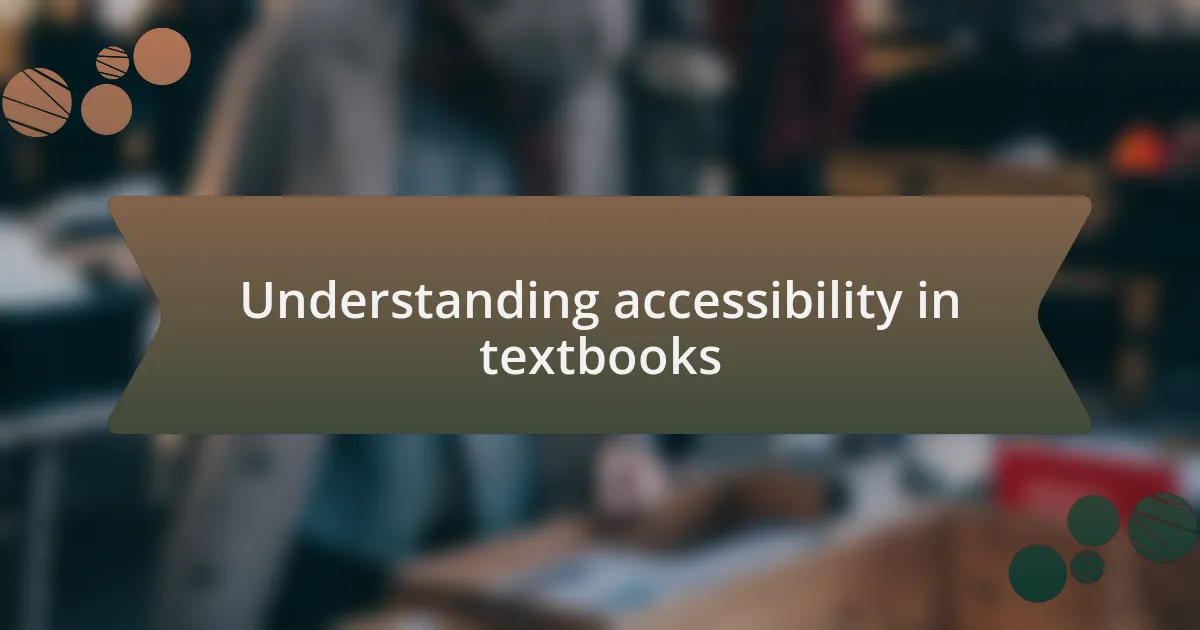
Understanding accessibility in textbooks
Accessibility in textbooks is not just about providing information; it’s about ensuring that every student can engage with that information effectively. I recall a time when I assisted a friend who struggled with visual impairments. We spent hours trying to decode complex diagrams that were not screen-reader friendly. It struck me then how often educational materials overlook such vital considerations.
When we think about access, it becomes clear that it involves more than just text; it encompasses multimedia elements, diagrams, and even font choices. I remember flipping through a particularly colorful textbook that looked appealing but had such small text that it was nearly impossible to read. Have you ever had a similar experience? It’s frustrating to encounter materials that are more about aesthetics than usability, which ultimately can discourage a person from learning.
Moreover, we must consider the emotional aspects of accessibility. For some, the struggle to obtain usable textbooks can lead to feelings of isolation or inadequacy. I once spoke to a classmate who felt lost in her studies simply because her textbook wasn’t available in an accessible format. Shouldn’t every student deserve an equal opportunity to succeed? Understanding accessibility in textbooks means recognizing these emotional barriers and actively working to dismantle them for a more inclusive learning environment.

Importance of accessibility in education
Accessibility in education isn’t just a legal requirement; it’s a moral obligation. I remember working with a student who had learning disabilities. She often had to rely on friends to read aloud from textbooks that weren’t available in formats she could easily comprehend. This experience made me realize that when educational resources are inaccessible, we’re not just hindering learning; we’re denying someone their right to explore knowledge fully.
Sometimes, I ponder how many talented individuals might feel discouraged simply because the materials set before them are out of reach. A former colleague once recounted the challenges she faced when her textbook lacked audio options. She shared how it affected her confidence and performance in class, highlighting that accessibility is deeply tied to a student’s self-assurance. Don’t we all want to foster an environment where every learner can thrive without barriers?
Moreover, accessibility in education can transform not just individual futures but entire communities. When I’ve mentored students from diverse backgrounds, I’ve seen firsthand how accessible learning materials foster inclusion and collaboration. It’s about creating an educational landscape that values every voice and perspective. Isn’t it crucial that we pave the way for a society that welcomes everyone, ensuring they can participate and contribute fully?
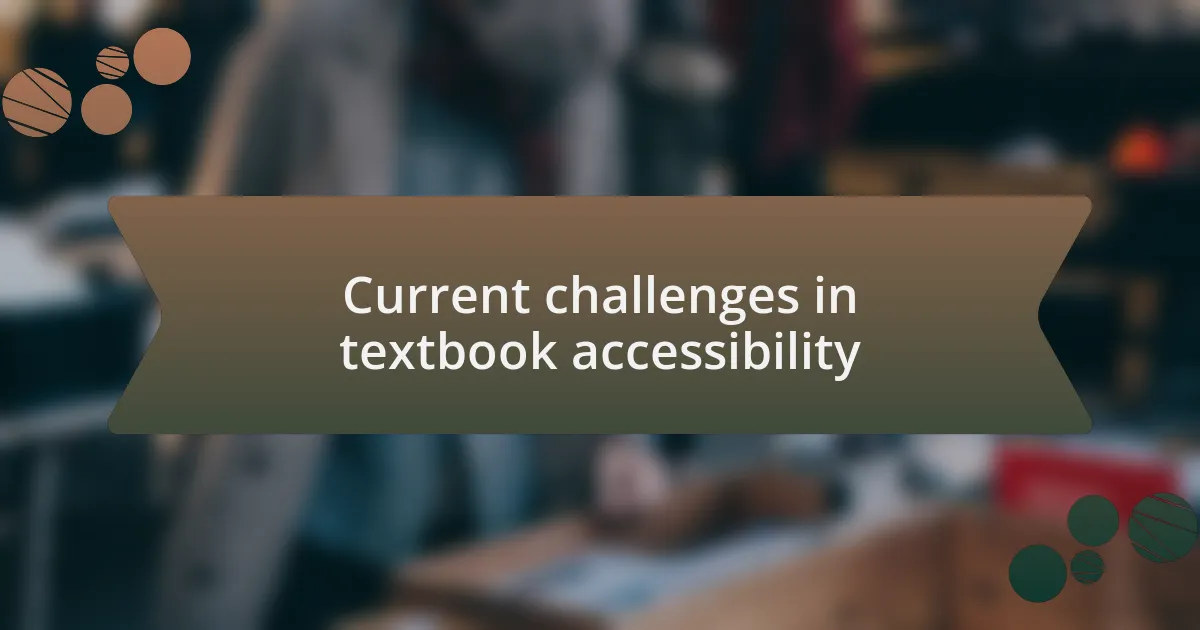
Current challenges in textbook accessibility
Textbook accessibility faces significant hurdles that often go unnoticed. One glaring issue is the lack of consistent formatting across various educational platforms. I remember a time when I tried to assist a visually impaired student who needed a digital version of her textbook. We discovered that the PDF version was not compatible with her screen reader, which meant she had to endure a frustrating struggle just to participate in class. Why should any student have to battle with technology simply to access the materials necessary for their education?
Another challenge lies in the financial constraints that publishers face when producing accessible texts. Creating formats like Braille, audio, or large print can be costly and time-consuming, which often leads to delays. I once collaborated with an educational publisher who expressed the difficulty of allocating budgets for these adaptations. In such situations, it’s disheartening to realize that educational equity can take a backseat to profit margins. Should we allow finances to dictate the learning opportunities available to students who need them the most?
Finally, the rapidly evolving technology landscape adds another layer of complexity to accessibility in textbooks. As new platforms and formats emerge, it can be overwhelming for educators and publishers to keep up. I often find myself questioning whether schools have the necessary training to implement these new tools effectively. If we cannot equip educators with the skills they need to utilize these resources, are we not just perpetuating the cycle of exclusion?
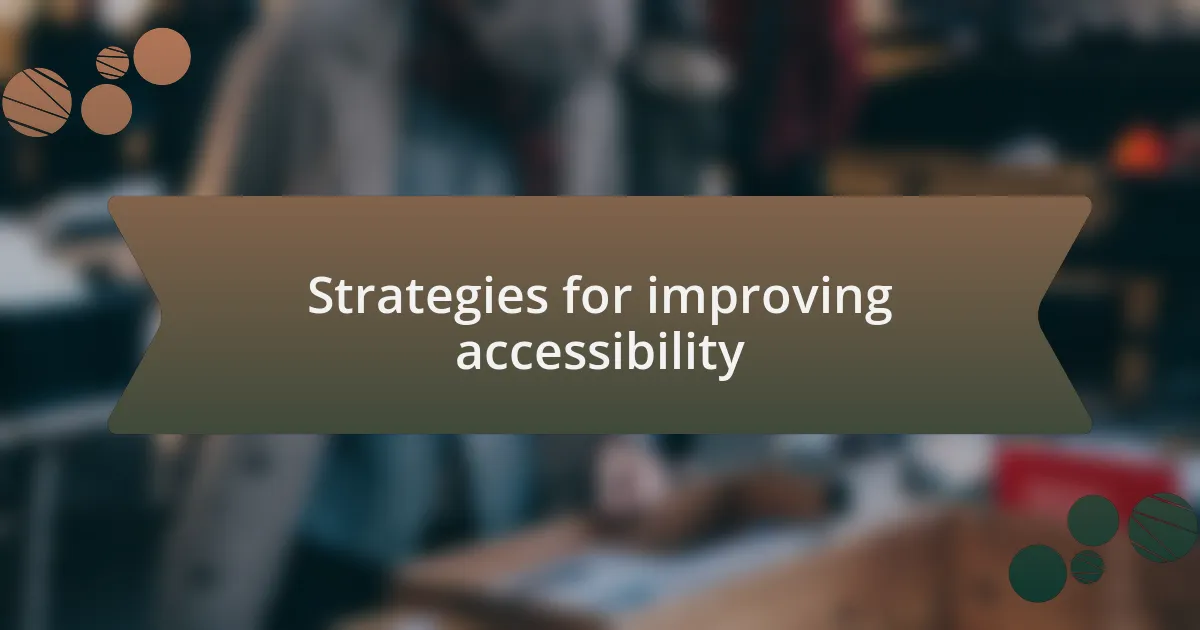
Strategies for improving accessibility
One effective strategy for improving accessibility is to prioritize universal design principles in the initial stages of textbook development. This approach involves creating materials that are usable for all students, regardless of their abilities. I vividly recall working on a project where we incorporated alternative text descriptions for images. The feedback from students was overwhelmingly positive; many felt more included and engaged when they could understand all aspects of the material, not just the text.
Training educators on accessibility practices shouldn’t be an afterthought either. I’ve seen first-hand the difference that a well-prepared teacher can make. During a workshop, one instructor shared how learning to use screen reading software transformed her entire teaching method. Imagine if all educators had access to this knowledge—how many more students could fully participate in their education? Isn’t it essential to empower teachers to foster an inclusive learning environment?
Finally, we should also leverage technology by providing a range of formats, such as eBooks and audiobooks. During a recent discussion with fellow educators, we emphasized how students with different learning preferences benefited immensely from having access to multiple formats. It struck me that offering these choices not only supports those requiring accommodations but also enhances learning for everyone. Isn’t it time we embraced flexibility in our materials to truly cater to diverse learning needs?
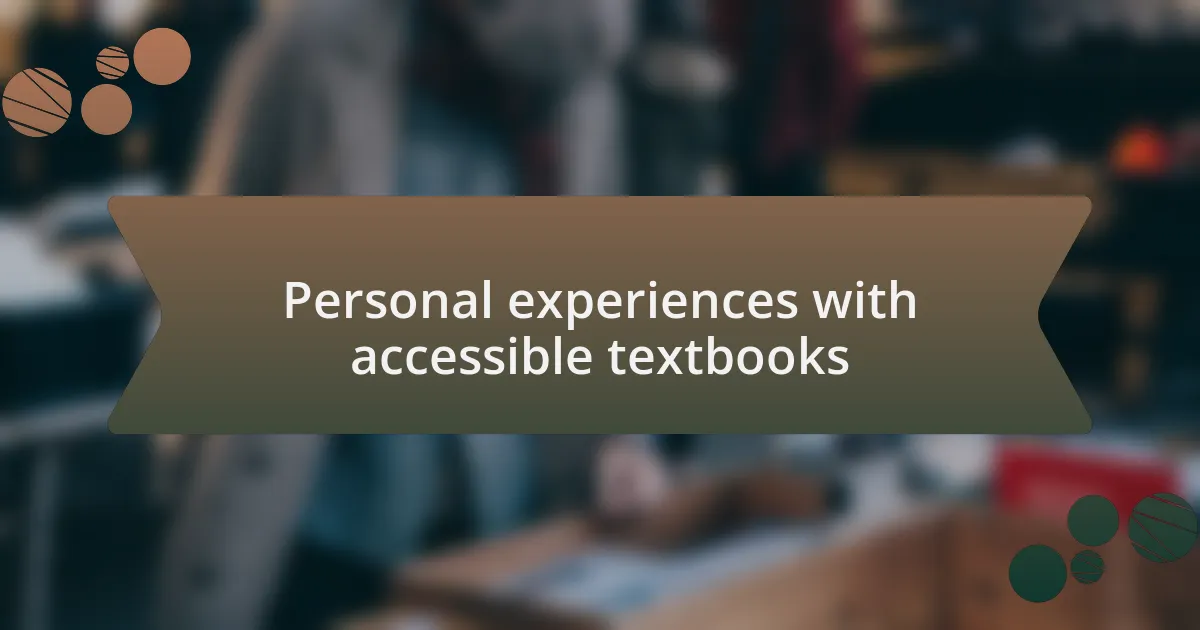
Personal experiences with accessible textbooks
Accessible textbooks have played a pivotal role in my journey as both a learner and an educator. I remember the relief I felt when I first used a textbook that included clear, concise captions alongside complex diagrams. It was as if someone had opened a window, allowing me to grasp the content without feeling overwhelmed. How transformative could this experience be for students who struggle with traditional formats?
In another instance, I once had a student who relied heavily on audiobooks due to a visual impairment. The moment I saw her actively participating and contributing to class discussions after we switched to a textbook with an excellent audio version was unforgettable. It made me realize how vital it is for us to cater to different learning styles. Can you imagine the empowerment she felt knowing she could engage on the same level as her peers?
From my perspective, the ongoing development of accessible materials truly feels like a collective responsibility. I often think about the stories of students who have never experienced that sense of belonging in an educational setting. Providing them with materials that acknowledge their needs is not just beneficial—it’s essential. After all, shouldn’t every student have the opportunity to thrive?
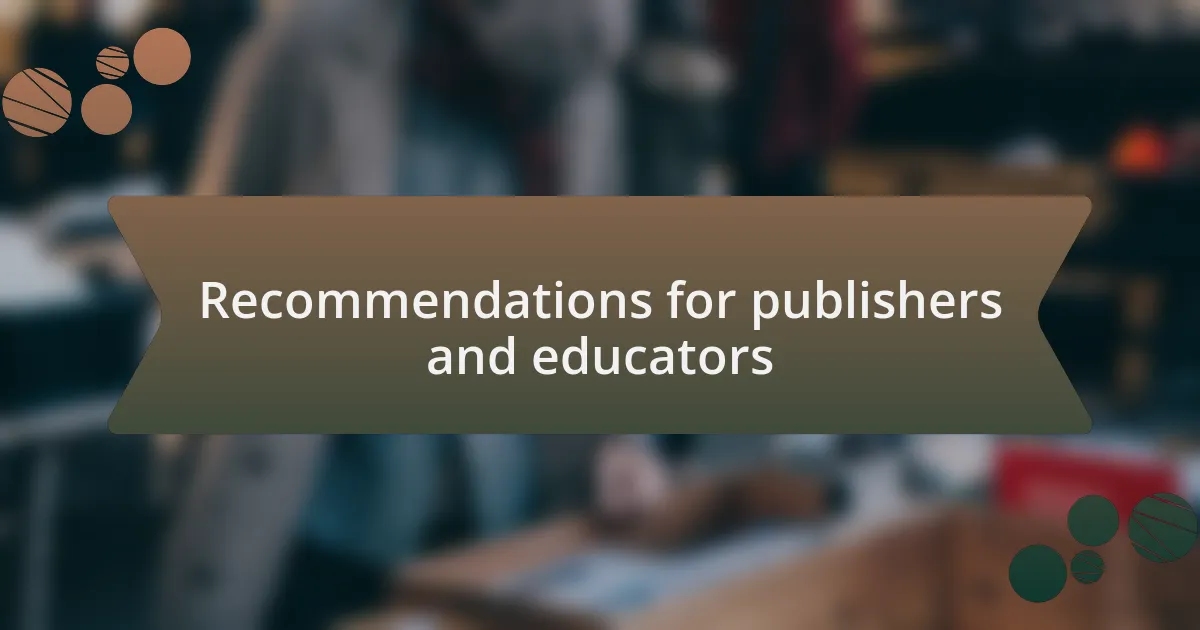
Recommendations for publishers and educators
Developing accessible textbooks should be a top priority for publishers and educators alike. I believe incorporating multisensory elements—such as audio, visual, and tactile materials—can significantly enhance comprehension for diverse learners. For example, I once collaborated with a publisher who added interactive elements in a textbook, which created a buzz in our classroom. Students were not just passive recipients of information; they were actively exploring concepts, and the engagement level skyrocketed.
It’s essential to regularly gather feedback from students about the materials we use. I remember how my own perspective shifted after implementing a student feedback system in my courses. Students expressed their challenges directly, leading us to revise our chosen textbooks to better suit their needs. It made me question: how often are we truly listening to the voices of those we aim to serve?
Lastly, I feel strongly that training educators on how to effectively use accessible materials can amplify their impact. For instance, I attended a workshop where I learned innovative strategies for presenting materials, and it transformed my approach to teaching. Ultimately, it’s about empowering educators with the tools to create an inclusive learning environment where every student feels valued and capable of success.